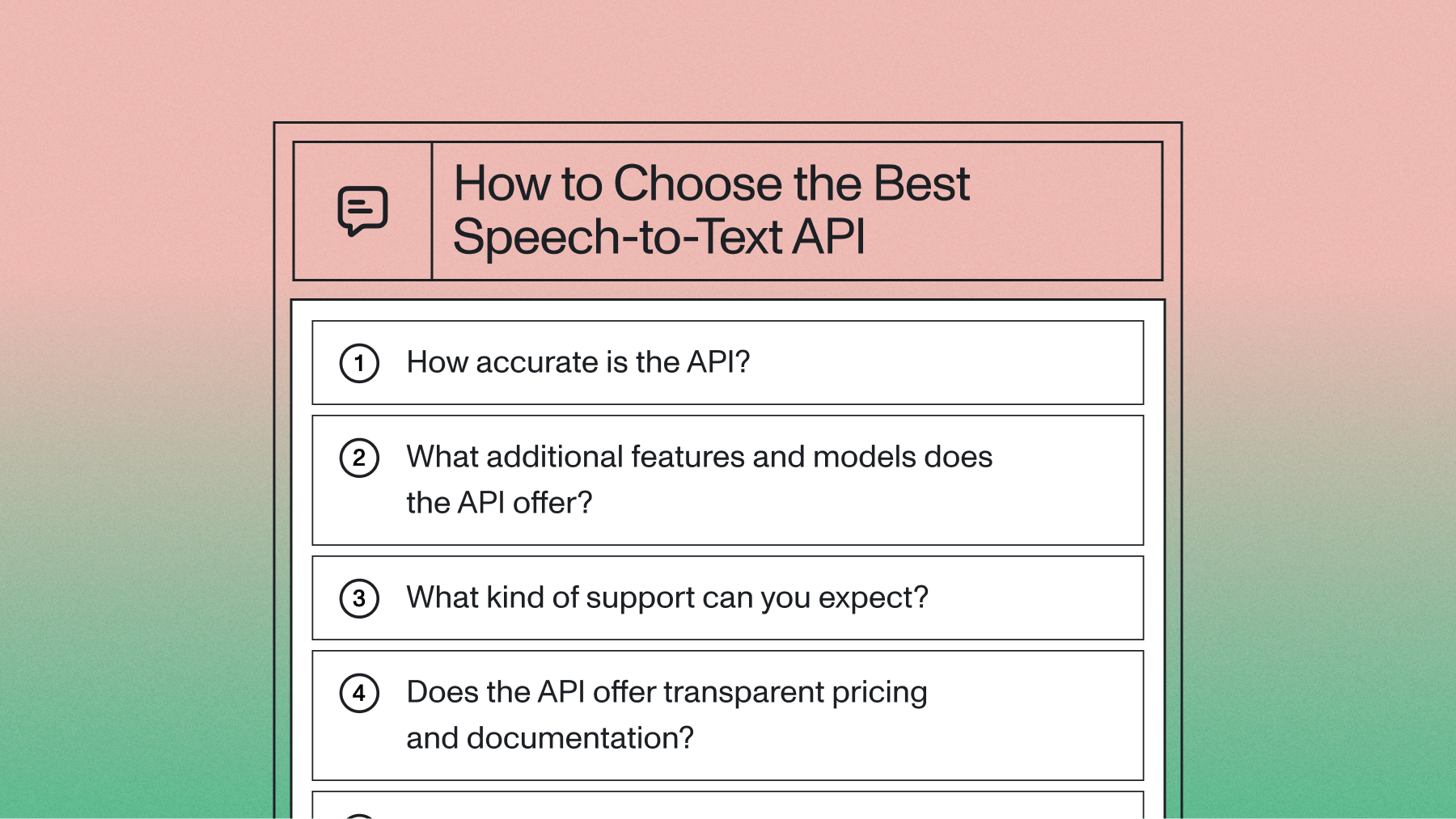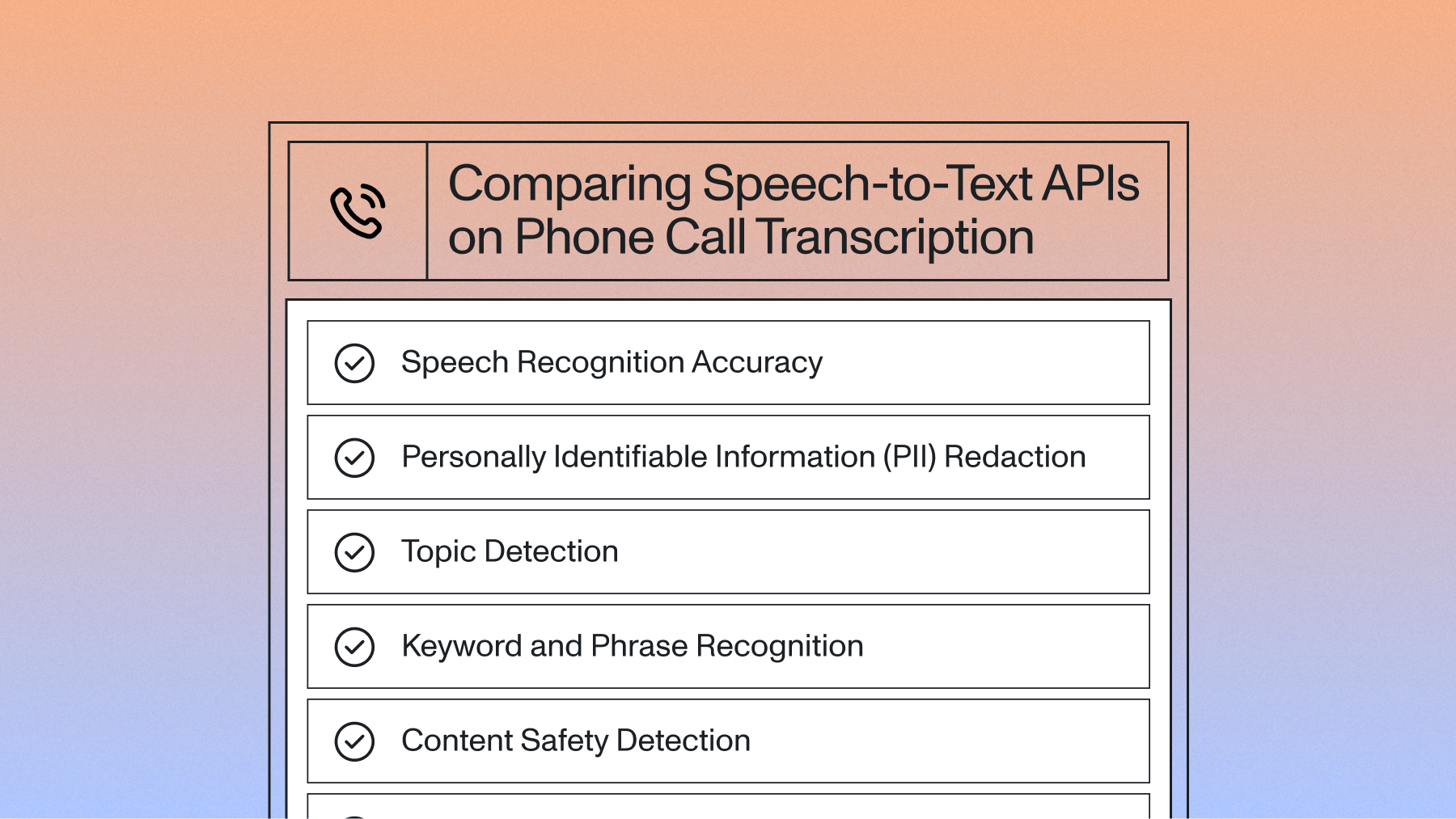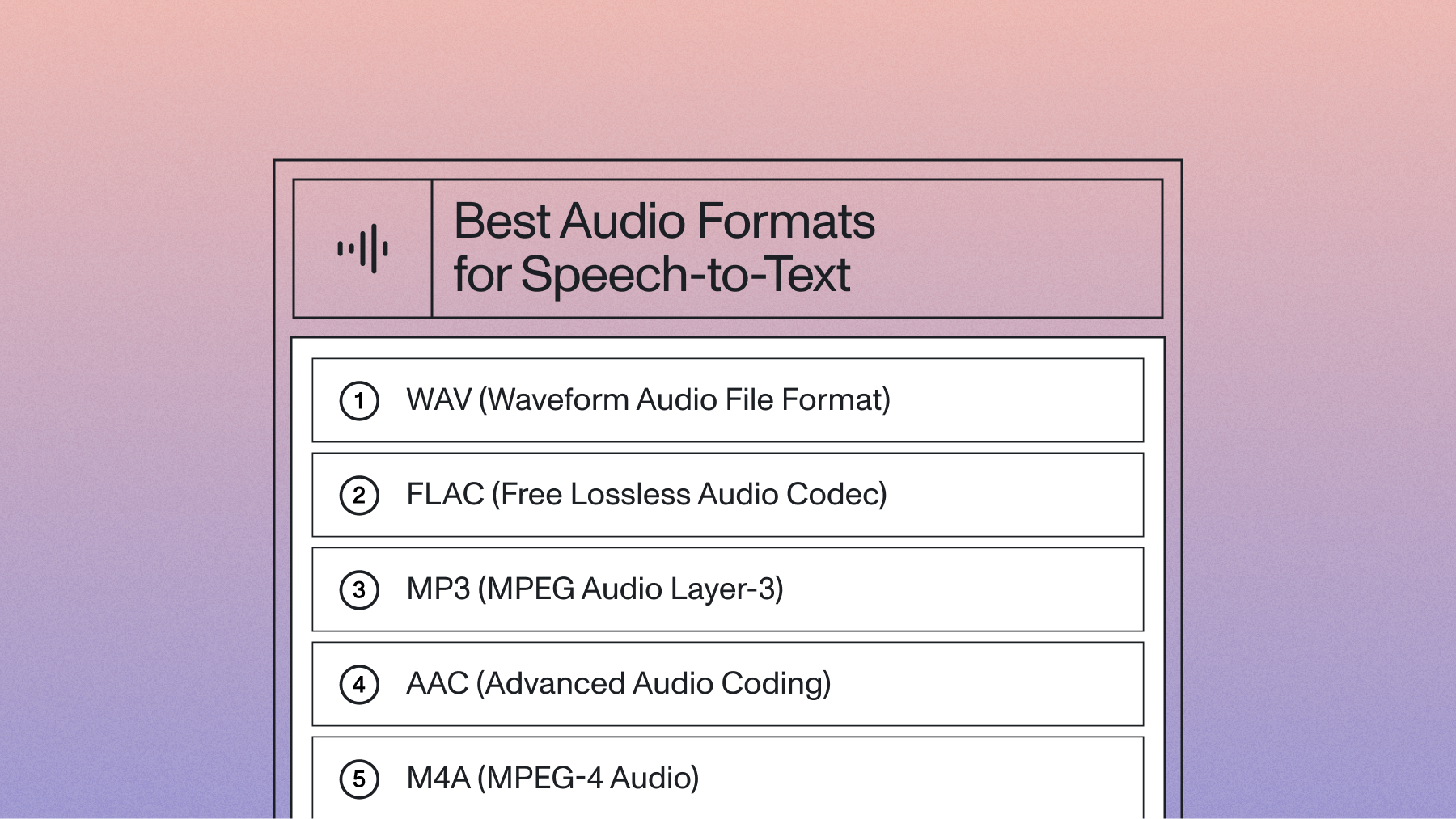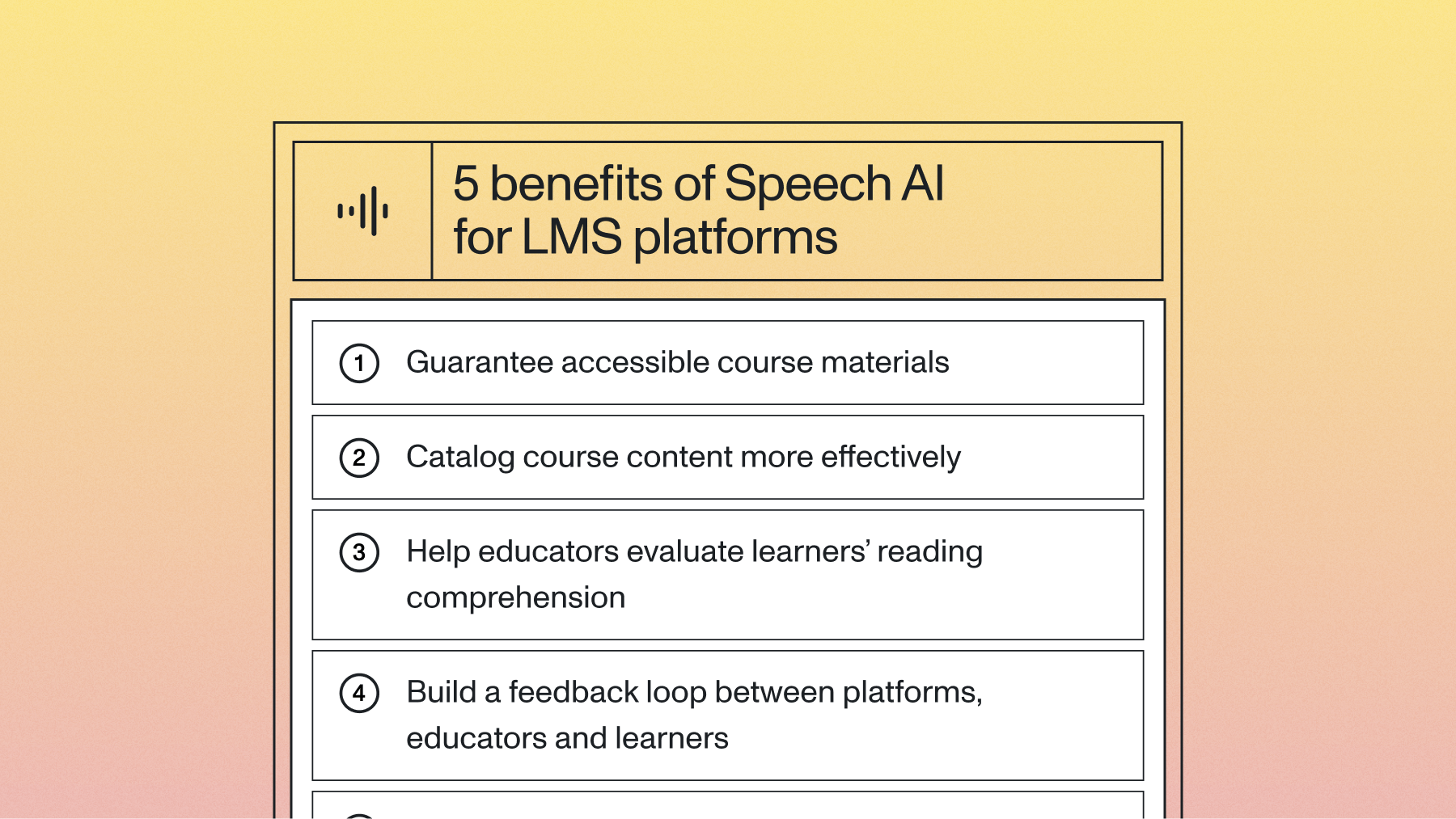How to choose the best speech-to-text API
With more speech-to-text APIs on the market than ever before, how do you choose the best one for your product or use case? Answering these six questions is a great starting point.



Speech-to-text APIs have become essential infrastructure for modern applications. From AI meeting assistants that generate automatic summaries to call centers analyzing thousands of customer conversations, these APIs power the voice features users now expect. But with more providers entering the market and technology advancing rapidly, choosing the right speech-to-text API requires understanding both the fundamentals and the evaluation criteria that matter for production deployments.
This guide walks through everything you need to know about speech-to-text APIs—from how they work and when to use them, to the specific questions that will help you identify the best solution for your needs. We'll cover the technical foundations, explore real-world applications, and provide a framework for evaluating different options based on accuracy, features, support, and other critical factors.
What is a speech-to-text API?
A speech-to-text API converts spoken words into written text through a simple developer interface. Developers send audio files or streams to the API endpoint and receive accurate transcriptions in return, eliminating the need to build complex Speech AI models from scratch. This enables companies to add voice-powered features like automated captions, meeting summaries, and voice commands to their applications.
How do speech-to-text APIs work?
The process is fairly simple from a developer's perspective. Your application makes a request to the API provider's endpoint, sending an audio file or a live stream of audio data. The provider's AI models then process the audio, converting the spoken words into text. The API returns this transcript to your application, often including additional data like word-level timestamps, speaker labels, and confidence scores. The entire underlying infrastructure for processing the audio at scale is managed by the API provider.
Common use cases for speech-to-text APIs
Speech-to-text APIs power a massive range of products and features across industries. For example, companies in the call center space like CallSource and Ringostat use APIs to transcribe and analyze customer interactions to improve agent performance. Media platforms like Veed and Podchaser rely on them to generate captions and transcripts for video and audio content, making it more accessible and searchable. And AI-powered meeting assistants from companies like Circleback AI use transcription as the foundation for creating automated summaries and action items.
How accurate is the API?
Accuracy is the most important consideration when comparing APIs. Word Error Rate, or WER, is the measure of accuracy of an Automatic Speech Recognition (ASR) system. It's calculated by comparing the ASR model's transcribed text to a human transcription.
The most thorough accuracy test involves calculating WER on your actual audio files. This requires human transcription of your files, API transcription of the same files, then comparing results to compute the error rate.
Read More: How Useful is Word Error Rate? →
For highly accurate transcription of pre-recorded, noisy audio, AssemblyAI offers its Universal model. For use cases requiring the highest possible accuracy on English audio, the Slam-1 model provides state-of-the-art performance with customization via prompting. These models achieve near-human level performance and robustness across a wide variety of data.
Another great resource for comparing API accuracy is Diffchecker. Diffchecker lets you compare two blocks of text--say from two different APIs or from one API and one human transcription--and shows you what has been added and what has been removed. It also lets you eyeball the differences between two large blocks of texts for a quick comparison.
When using Diffchecker, evaluate these key accuracy factors:
- Missed content: What words or phrases did the API fail to capture?
- Capitalization: Are proper nouns correctly formatted?
- Accent handling: Does speaker dialect affect accuracy?
- Context understanding: Did the API grasp conversational context?
See this text comparison using Diffchecker as an example:

As you can see, Text 1 has 12 removals and Text 2 has 11 additions. Look closely at the highlighted text to spot some of the nuances, such as "black as" in Text 1 vs. "Black is" in Text 2.
Together, WER and Diffchecker can be powerful tools for determining accuracy. This article is also a great option for completing a thorough speech recognition api comparison.
What additional features and models does the API offer?
Next, you should see what additional features the API offers. This will help you get more out of the raw transcription.
Beyond core transcription, you can enable a suite of Speech Understanding models to extract more value from your audio data. Common models include:
- Summarization: Generate summaries of audio files in various formats.
- Speaker Diarization: Identify and label different speakers in the audio.
- PII Redaction: Automatically detect and remove personally identifiable information.
- Auto Chapters: Automatically segment audio into chapters with summaries.
- Topic Detection: Classify audio content based on the IAB standard.
- Content Moderation: Detect sensitive or inappropriate content.
- Paragraph and Sentence Segmentation: Automatically break transcripts into readable paragraphs and sentences.
- Sentiment Analysis: Analyze the sentiment of each sentence.
- Confidence Scores: Get word-level and transcript-level confidence scores.
- Automatic Punctuation and Casing: Improve readability with automatic formatting.
- Profanity Filtering: Censor profane words in the transcript.
- Entity Detection: Identify named entities like people, places, and organizations.
- Accuracy Boosting (Keyterms & Custom Vocabulary): Improve accuracy for specific terms and phrases.
And more.
When choosing a speech-to-text API, you should also evaluate how often new features are released and how often the models are updated.
The best speech-to-text APIs maintain dedicated AI research teams that continuously improve models based on new breakthroughs. Since many ASR features haven't reached human accuracy levels yet, choose providers that demonstrate ongoing model improvements.
Make sure you check the API's changelog and updates, which should be transparent and easily accessible. For example, AssemblyAI ships updates weekly via its publicly accessible changelog. If an API doesn't have a changelog, or doesn't update it very often, this is a red flag.
What kind of support can you expect?
Too often, APIs offered by big tech companies like Google Cloud and AWS go unsupported and are infrequently updated.
It's inevitable that you'll have questions or need support as you leverage a Speech-to-Text API to build new features into your product. This is why you should look for an API that offers dedicated, quick support to you and your team of developers. Support should be offered 24/7 via multiple channels such as email, messaging, or Slack.
You should be assigned a dedicated account manager and support engineer that offer integration support, provide quick turnaround on support requests, and help you figure out the best features to integrate.
Also consider:
- Uptime reports (should be at or near 100%)
- Customer reviews and awards on sites like G2
- Accessible changelog with detailed and frequent updates, as discussed above
- Quick, helpful support via multiple channels
Does the API offer transparent pricing and documentation?
API pricing shouldn't be a guessing game. All APIs you are considering should offer transparent, easy-to-decipher pricing as well as volume discounts for high levels of usage. A free trial for the API that lets you explore the API before committing to purchase is even better.
Watch for these common pricing and integration challenges:
- Hidden costs: Google Cloud requires data hosting in GCP Buckets, increasing total expenses
- File size limits: OpenAI Whisper's 25MB chunks complicate large file processing
- Documentation quality: Poor API documentation signals difficult integration
How secure is your data?
Data security becomes critical when processing sensitive voice data through third-party APIs. Evaluate these essential security measures:
- Encryption: End-to-end encryption for data in transit and at rest
- Compliance certifications: SOC 2 Type 2, HIPAA, GDPR compliance as needed
- Data retention policies: Clear policies on how long audio and transcripts are stored
- Access controls: Robust authentication and authorization mechanisms
For comprehensive guidance, see our detailed analysis of speech-to-text security considerations.
Is innovation a priority?
The field of Speech-to-Text recognition is in a state of constant innovation. Any API you consider should have a strong focus on AI research.
Also ensure that the API directs its research toward frequent model updates. The field of Speech AI is advancing rapidly, and even mature features like Speaker Diarization and Sentiment Analysis benefit from continuous improvement. Choose a provider that is committed to pushing the boundaries of accuracy and functionality across their entire suite of models.
The API's changelogs are a good way to determine the difference between an API stating they prioritize innovation and an API demonstrating that they are truly innovating. Pay attention to descriptions of model versioning and how they split up model updates.
For example, AssemblyAI ships detailed updates for all its models and features via its changelog regularly. Others may have a changelog but give limited insight.
Getting started with a speech-to-text API
Integrating a speech-to-text API is usually a quick process. Most providers, including AssemblyAI, follow a similar developer workflow:
- Get an API key: Sign up for a free account to get an API key that authenticates your requests.
- Read the documentation: Review the API docs to understand the available endpoints, parameters, and SDKs for your programming language.
- Make your first request: Send your first audio file to the API and get a transcript back. From there, you can explore more advanced features.
Choosing the right speech-to-text API
There is obviously a lot to think about when comparing Speech-to-Text APIs.
To summarize, here are the key questions to ask each API:
- How accurate is the API?
- What additional features does the API offer?
- What kind of support can you expect?
- Does the API offer transparent pricing and documentation?
- How secure is your data?
- Is innovation a priority?
Taking the time to do research now will set you up for long-term success with your Speech-to-Text API partner.
If you're interested in trying our API, get your free speech-to-text API key and transcribe your own audio data.
Frequently asked questions about speech-to-text APIs
Are there free speech-to-text APIs?
Yes, many providers offer free tiers, and open source models like Whisper are available. Commercial APIs handle infrastructure complexity, while open source requires self-hosting and maintenance.
How is accuracy measured for speech-to-text?
Speech-to-text accuracy is measured using Word Error Rate (WER), which compares API transcripts to human-verified text to calculate error percentages.
What's the difference between real-time and asynchronous transcription?
Asynchronous transcription processes pre-recorded files and returns complete transcripts, while real-time transcription converts live audio streams into text as speech happens.
Lorem ipsum dolor sit amet, consectetur adipiscing elit, sed do eiusmod tempor incididunt ut labore et dolore magna aliqua. Ut enim ad minim veniam, quis nostrud exercitation ullamco laboris nisi ut aliquip ex ea commodo consequat. Duis aute irure dolor in reprehenderit in voluptate velit esse cillum dolore eu fugiat nulla pariatur.





